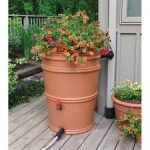As the recent flooding in Missouri has so tragically shown, storm water management is an issue that must receive serious attention. As rampant development continues in this country, the earth is being smothered under the impervious surfaces of our buildings, roofs, driveways, streets, parking lots, and shopping centers.
Our current method of dealing with the amount of rainwater that collects on these surfaces is to funnel this water from gutters and downspouts and stormdrains into our sewer system or into streams. We spend millions of dollars directing water away from the place where it falls and into our waterways.
A much better option may be to manage water where it falls—allowing rainwater to infiltrate into the earth, storing water in the soil and recharging groundwater levels.
A roof of 1000 square feet can generate 600 gallons of rain as runoff for every inch of rain. Multiply these 600 gallons by all the houses in your neighborhood all dumping this runoff into our streams at the same time.
These streams may handle a one inch rain event with no problem, but larger rain events may cause significant problems, such as the horrible flooding just observed in the Midwest.
The streams simply cannot handle large volumes of water entering them at the same time. This amount of runoff can cause severe erosion, pollution, sedimentation, and flooding downstream.
Under natural conditions water collects on vegetation and slowly seeps into the soil, recharging groundwater levels, and slowly finding its way into streams. Current development treats this water as a waste product, with the goal of removing it from a site as soon as possible. A much better option would be to manage this water where it falls.
Managing water onsite may involve several different options, which can be used singly or in combination, with each added element providing that much more toward the goal of managing 100% of runoff from each site.
- Rain barrels provide the easiest method of water collection. These are easy to install and are able to capture rainwater for later use in garden irrigation. With the rising cost of municipal water and drought restrictions across much of the US in the summer months, this method provides a means of conserving water and protecting our water supply.
- Green roofs provide an insulating layer to a building, making it warmer in the winter and cooler in the summer, and therefore reducing heating and cooling costs. These roofs also slow the flow of rainwater into downspouts which reduces the amount of runoff flowing into streams. These roofs may also provide habitat for insects and nesting birds by mimicking rare or endangered ecosystems such as Midwestern prairies.
- Stormwater Swales keep rainwater off of roadways and allow it to seep slowly back to the water table. They also provide excellent wildlife habitat.
Green Roof Resources:
- Green Roof Construction and Maintenance, by Kelly Luckett
- Planting Green Roofs and Living Walls, by Nigel Dunnett and Noel Kingsbury
- The installation of porous paving for driveways and patios will allow rainwater to infiltrate the ground instead of running off into sewer systems. Many materials are available for this use from commercially available pavers to recycled products such as crushed brick and concrete.
- A rain garden is a shallow depression located near the runoff from a downspout. Rainwater will collect in the garden and percolate into the soil, recharge groundwater levels, and slowly make its way into streams and watersheds. These beautiful gardens, when planted with native plants, can greatly increase biodiversity in our yards.Rain gardens are discussed and beautifully photographed in Nigel Dunnett and Andy Clayden’s Rain Gardens: Managing Water Sustainably in the Garden and Designed Landscape
More From Ecosystem Gardening:
Submit your review | |








